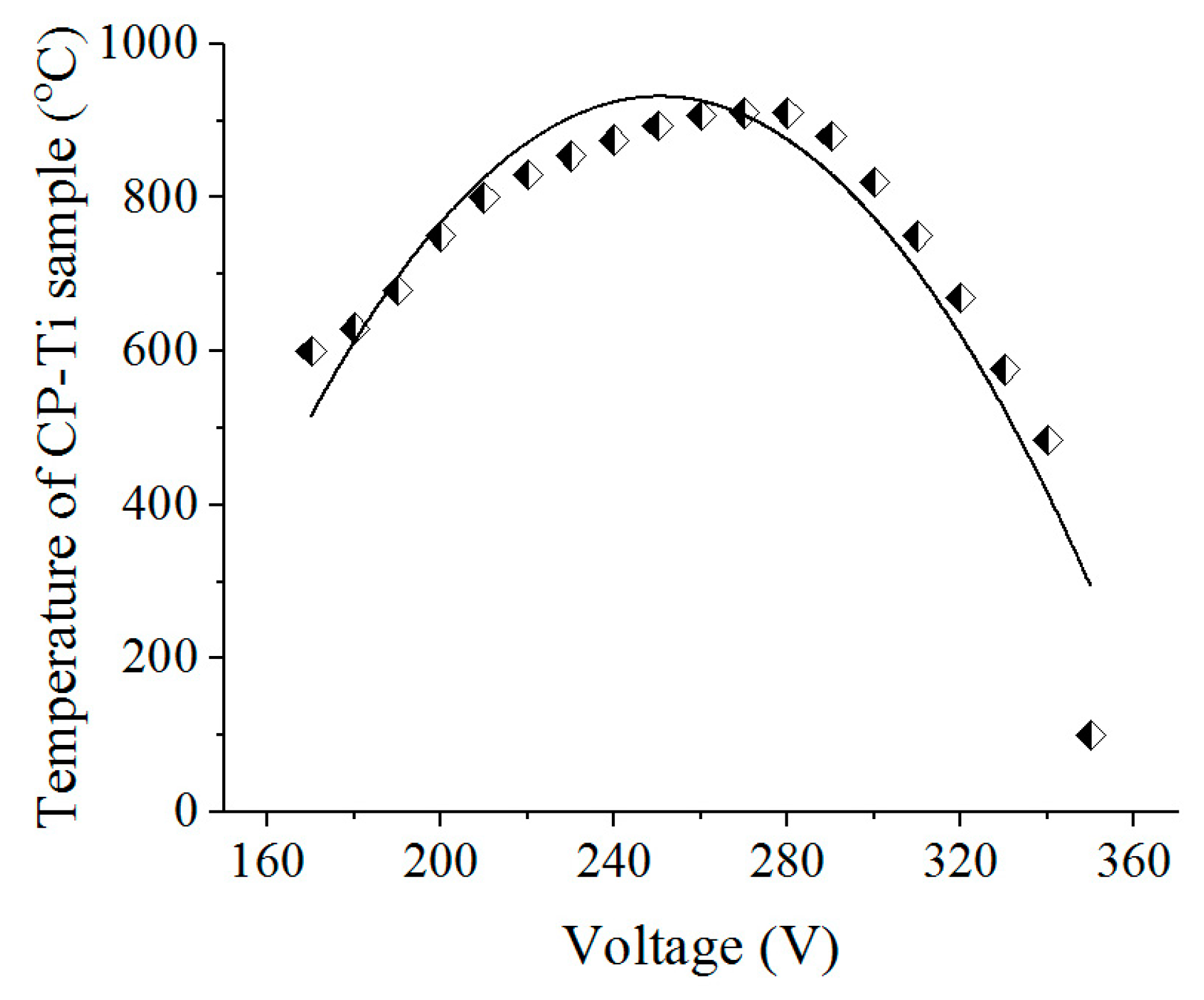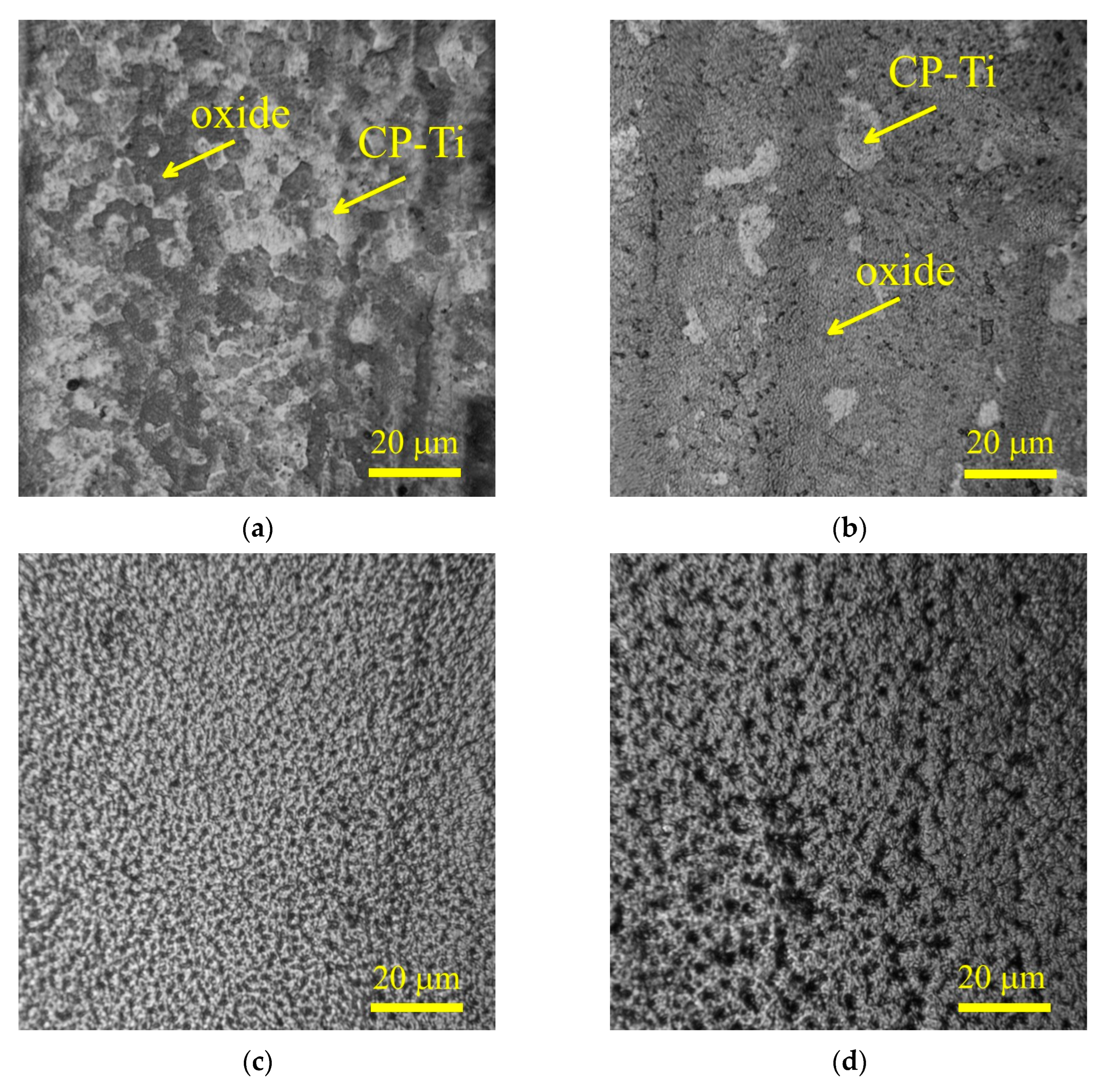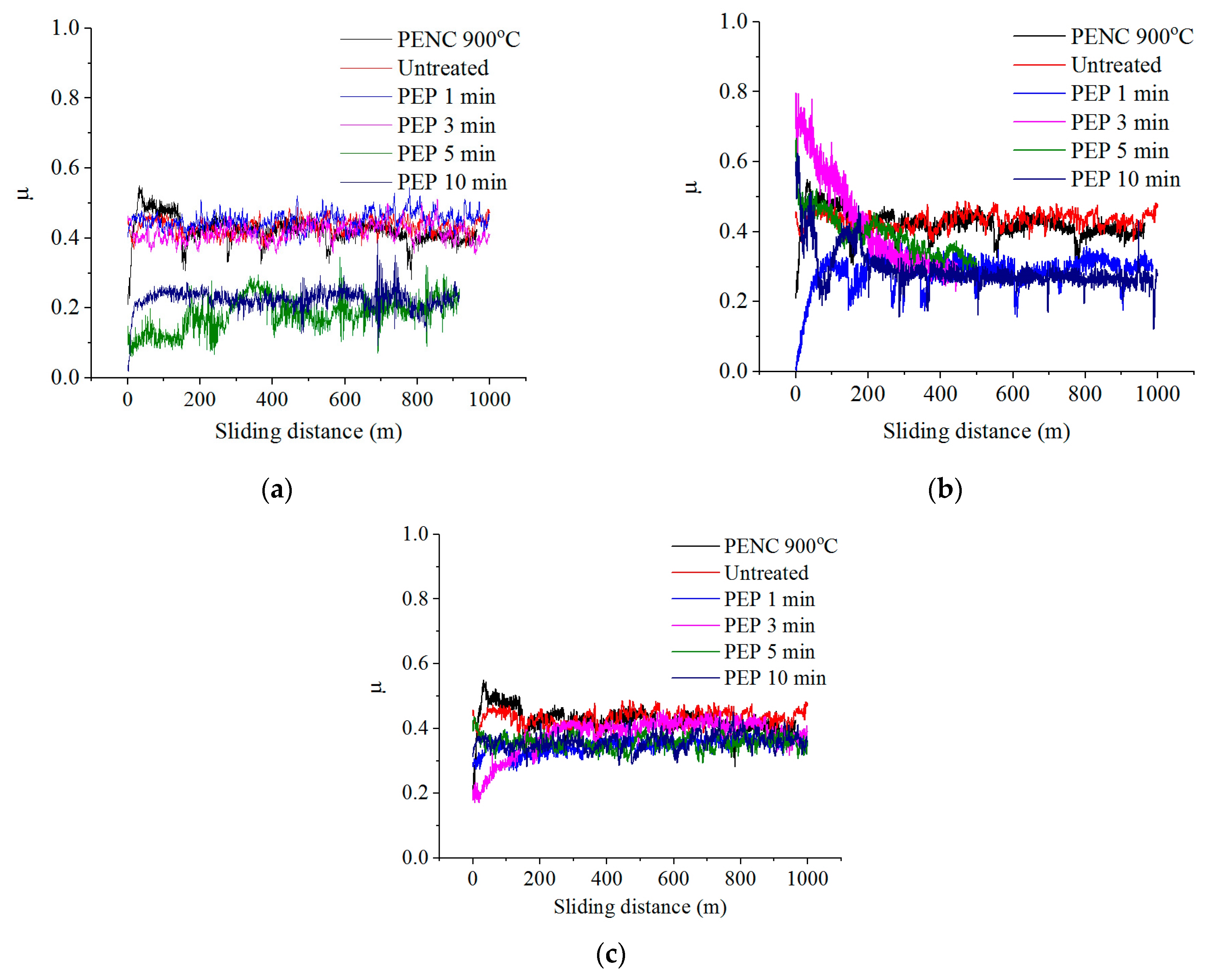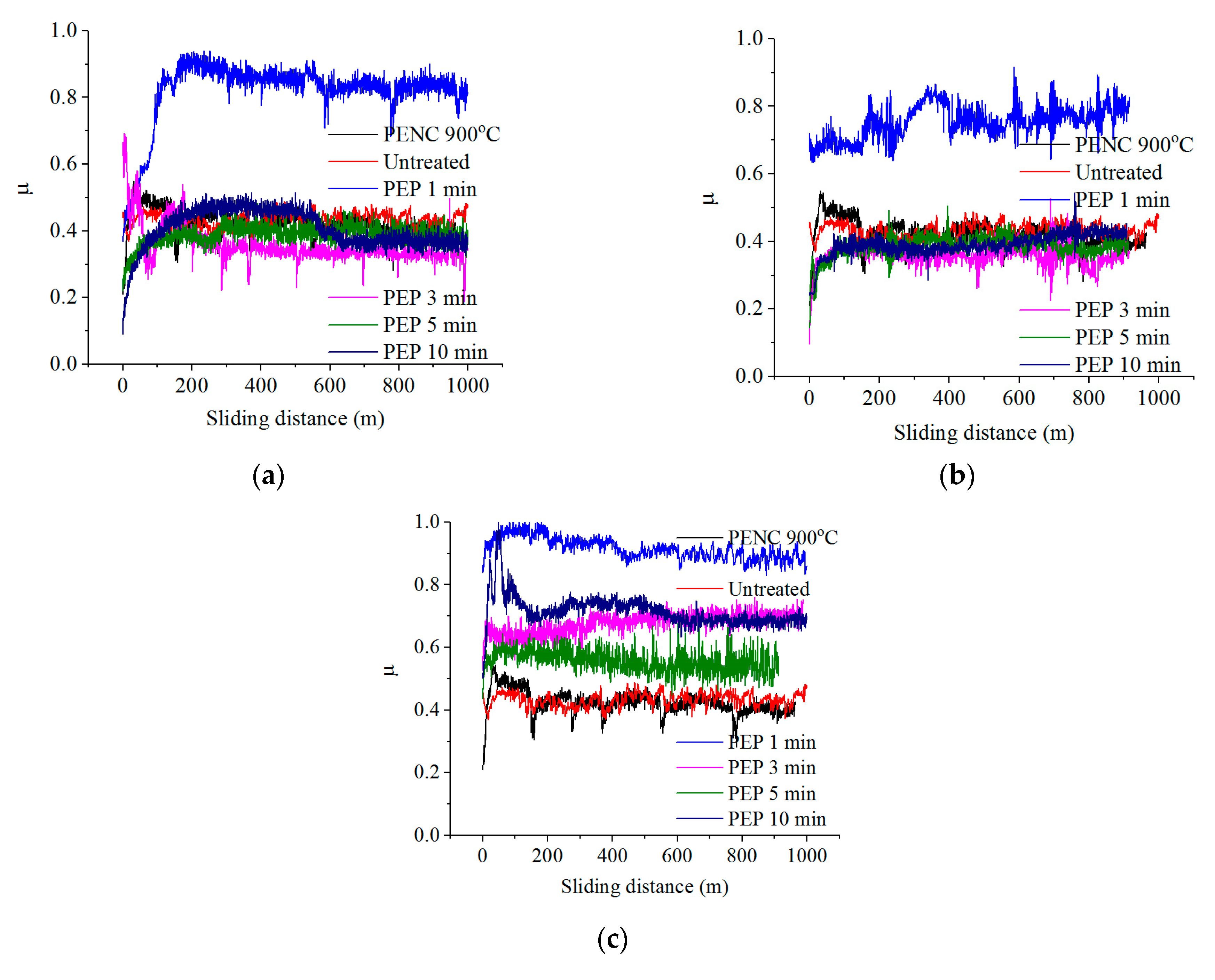Possibilities of Duplex Plasma Electrolytic Treatment for Increasing the Hardness and Wear Resistance of a Commercially Pure Titanium Surface
Abstract
:1. Introduction
2. Materials and Methods
2.1. Sample Processing
2.2. Study of the Surface Morphology and Microstructure
2.3. Microhardness Measurement
2.4. Surface Roughness and Sample Weight Measurement
2.5. Study of Tribological Properties
3. Results
3.1. Morphology, Structure, and Tribological Properties of the Surface after PENC
3.2. Morphology and Tribological Properties of the Surface after PEP
4. Discussion
5. Conclusions
Author Contributions
Funding
Institutional Review Board Statement
Informed Consent Statement
Data Availability Statement
Conflicts of Interest
References
- Yin, F.; Hu, S.; Xu, R.; Han, X.; Qian, D.; Wei, W.; Hua, L.; Zhao, K. Strain rate sensitivity of the ultrastrong gradient nanocrystalline 316L stainless steel and its rate-dependent modeling at nanoscale. Int. J. Plast. 2020, 129, 102696. [Google Scholar] [CrossRef]
- Li, P.; Hu, S.; Liu, Y.; Hua, L.; Yin, F. Surface Nanocrystallization and Numerical Modeling of 316L Stainless Steel during Ultrasonic Shot Peening Process. Metals 2022, 12, 1673. [Google Scholar] [CrossRef]
- Chen, Y.; Deng, S.; Zhu, C.; Hu, K.; Yin, F. The effect of ultrasonic shot peening on the fatigue life of alloy materials: A review. Int. J. Comput. Mater. Sci. Surf. Eng. 2021, 10, 209–234. [Google Scholar] [CrossRef]
- Yerokhin, A.L.; Nie, X.; Leyland, A.; Matthews, A.; Dowey, S. Plasma electrolysis for surface engineering. Surf. Coat. Technol. 1999, 122, 73–93. [Google Scholar] [CrossRef]
- Mora-Sanchez, H.; Pixner, F.; Buzolin, R.; Mohedano, M.; Arrabal, R.; Warchomicka, F.; Matykina, E. Combination of Electron Beam Surface Structuring and Plasma Electrolytic Oxidation for Advanced Surface Modification of Ti6Al4V Alloy. Coatings 2022, 12, 1573. [Google Scholar] [CrossRef]
- Perez, H.; Vargas, G.; Magdaleno, C.; Silva, R. Article: Oxy-Nitriding AISI 304 Stainless Steel by Plasma Electrolytic Surface Saturation to Increase Wear Resistance. Metals 2023, 13, 309. [Google Scholar] [CrossRef]
- Marcuz, N.; Ribeiro, R.P.; Rangel, E.C.; Cristino da Cruz, N.; Correa, D.R.N. The Effect of PEO Treatment in a Ta-Rich Electrolyte on the Surface and Corrosion Properties of Low-Carbon Steel for Potential Use as a Biomedical Material. Metals 2023, 13, 520. [Google Scholar] [CrossRef]
- Aliofkhazraei, M.; Macdonald, D.D.; Matykina, E.; Parfenov, E.V.; Egorkin, V.S.; Curran, J.A.; Troughton, S.C.; Sinebryukhov, S.L.; Gnedenkov, S.V.; Lampke, T.; et al. Review of plasma electrolytic oxidation of titanium substrates: Mechanism, properties, applications and limitations. Appl. Surf. Sci. Adv. 2021, 5, 100121. [Google Scholar] [CrossRef]
- Jin, S.; Ma, X.; Wu, R.; Wang, G.; Zhang, J.; Krit, B.; Betsofen, S.; Liu, B. Advances in micro-arc oxidation coatings on Mg-Li alloys. Appl. Surf. Sci. Adv. 2022, 8, 100219. [Google Scholar] [CrossRef]
- Bogdashkina, N.L.; Gerasimov, M.V.; Zalavutdinov, R.K.; Kasatkina, I.V.; Krit, B.L.; Lyudin, V.B.; Fedichkin, I.D.; Shcherbakov, A.I.; Apelfeld, A.V. Influence of Nickel Sulfate Additives to Electrolytes Subjected to Microarc Oxidation on the Structure, Composition, and Properties of Coatings Formed on Titanium. Surf. Eng. Appl. Electrochem. 2018, 54, 331–337. [Google Scholar] [CrossRef]
- Bordbar-Khiabani, A.; Ebrahimi, S.; Yarmand, B. Highly corrosion protection properties of plasma electrolytic oxidized titanium using rGO nanosheets. Appl. Surf. Sci. 2019, 486, 153–165. [Google Scholar] [CrossRef]
- Kim, S.-P.; Kaseem, M.; Choe, H.-C. Plasma electrolytic oxidation of Ti-25Nb-xTa alloys in solution containing Ca and P ions. Surf. Coat. Technol. 2020, 395, 125916. [Google Scholar] [CrossRef]
- Maltanava, H.; Stojadinovic, S.; Vasilic, R.; Karpushenkov, S.; Belko, N.; Samtsov, M.; Poznyak, S. Photoluminescent Coatings on Zinc Alloy Prepared by Plasma Electrolytic Oxidation in Aluminate Electrolyte. Coatings 2023, 13, 848. [Google Scholar] [CrossRef]
- Stojadinović, S.; Jovović, J.; Petković, M.; Vasilić, R.; Konjević, N. Spectroscopic and Real-Time Imaging Investigation of Tantalum Plasma Electrolytic Oxidation (PEO). Surf. Coat. Technol. 2011, 205, 5406–5413. [Google Scholar] [CrossRef]
- Schorn, L.; Wilkat, M.; Lommen, J.; Borelli, M.; Muhammad, S.; Rana, M. Plasma Electrolytic Polished Patient-Specific Orbital Implants in Clinical Use—A Technical Note. J. Pers. Med. 2023, 13, 148. [Google Scholar] [CrossRef]
- Danilov, I.; Hackert-Oschatzchen, M.; Zinecker, M.; Meichsner, G.; Edelmann, J.; Schubert, A. Process Understanding of Plasma Electrolytic Polishing through Multiphysics Simulation and Inline Metrology. Micromachines 2019, 10, 214. [Google Scholar] [CrossRef] [Green Version]
- Cornelsen, M.; Deutsch, C.; Seitz, H. Electrolytic Plasma Polishing of Pipe Inner Surfaces. Metals 2017, 8, 12. [Google Scholar] [CrossRef] [Green Version]
- Navickaitė, K.; Ianniciello, L.; Tušek, J.; Engelbrecht, K.; Bahl, C.R.H.; Penzel, M.; Nestler, K.; Böttger-Hiller, F.; Zeidler, H. Plasma Electrolytic Polishing of Nitinol: Investigation of Functional Properties. Materials 2021, 14, 6450. [Google Scholar] [CrossRef]
- Nestler, K.; Böttger-Hiller, F.; Adamitzki, W.; Glowa, G.; Zeidler, H.; Schubert, A. Plasma electrolytic polishing—An overview of applied technologies and current challenges to extend the polishable material range. Procedia CIRP 2016, 42, 503–507. [Google Scholar] [CrossRef]
- Ma, G.; Li, S.; Liu, X.; Yin, X.; Jia, Z.; Liu, F. Combination of Plasma Electrolytic Processing and Mechanical Polishing for Single-Crystal 4H-SiC. Micromachines 2021, 12, 606. [Google Scholar] [CrossRef]
- Parfenov, E.V.; Farrakhov, R.G.; Mukaeva, V.R.; Gusarov, A.V.; Nevyantseva, R.R.; Yerokhin, A. Electric field effect on surface layer removal during electrolytic plasma polishing. Surf. Coat. Technol. 2016, 307, 1329–1340. [Google Scholar] [CrossRef]
- Stepputat, V.N.; Zeidler, H.; Safranchik, D.; Strokin, E.; Böttger-Hiller, F. Investigation of Post-Processing of Additively Manufactured Nitinol Smart Springs with Plasma-Electrolytic Polishing. Materials 2021, 14, 4093. [Google Scholar] [CrossRef] [PubMed]
- Ablyaz, T.R.; Shlykov, E.S.; Muratov, K.R.; Osinnikov, I.V.; Bannikov, M.V.; Sidhu, S.S. Investigation of Plasma-Electrolytic Processing on EDMed Austenitic Steels. Materials 2023, 16, 4127. [Google Scholar] [CrossRef] [PubMed]
- Zhang, T.; Wu, J.; Jin, L.; Zhang, Z.; Rong, W.; Zhang, B.; Wang, Y.; He, Y.; Liu, W.; Li, X. Enhancing the mechanical and anticorrosion properties of 316L stainless steel via a cathodic plasma electrolytic nitriding treatment with added PEG. J. Mater. Sci. Technol. 2019, 35, 2630–2637. [Google Scholar] [CrossRef]
- Nie, X.; Wang, L.; Yao, Z.C.; Zhang, L.; Cheng, F. Sliding wear behaviour of electrolytic plasma nitrided cast iron and steel. Surf. Coat. Technol. 2005, 200, 1745–1750. [Google Scholar] [CrossRef]
- Taheri, P.; Dehghanian, C.; Aliofkhazraei, M.; Rouhaghdam, A.S. Evaluation of Nanocrystalline Microstructure, Abrasion, and Corrosion Properties of Carbon Steel Treated by Plasma Electrolytic Boriding. Plasma Process. Polym. 2007, 4, S711–S716. [Google Scholar] [CrossRef]
- Kuzenkov, S.E.; Saushkin, B.P. Borating of steel 45 in electrolytic plasma. Surf. Eng. Appl. Electrochem. 1996, 6, 10–15. [Google Scholar]
- Aliofkhazraei, M.; Taheri, P.; Sabour Rouhaghdam, A.; Dehghanian, C. Study of nanocrystalline plasma electrolytic carbonitriding for CP-Ti. Mater. Sci. 2007, 43, 791–799. [Google Scholar] [CrossRef]
- Dong, Y.-X.; Chen, Y.-S.; Chen, Q.; Liu, B.; Song, Z.-X. Characterization and blood compatibility of TiCxN1−x hard coating prepared by plasma electrolytic carbonitriding. Surf. Coat. Technol. 2007, 201, 8789–8795. [Google Scholar] [CrossRef]
- Hu, Z.; Xie, F.; Liu, Y.; Wu, X. Study of plasma electrolytic nitrocarburizing on surface of titanium alloy. Mater. Rev. 2008, 4. Available online: http://en.cnki.com.cn/Article_en/CJFDTOTAL-CLDB200804037.htm (accessed on 5 June 2023).
- Li, X.-M.; Han, Y. Mechanical properties of Ti(C0.7N0.3) film produced by plasma electrolytic carbonitriding of Ti6Al4V alloy. Appl. Surf. Sci. 2008, 254, 6350–6357. [Google Scholar] [CrossRef]
- Kusmanov, S.A.; Tambovskii, I.V.; Korableva, S.S.; Mukhacheva, T.L.; D’yakonova, A.D.; Nikiforov, R.V.; Naumov, A.R. Wear resistance increase in Ti6Al4V titanium alloy using a cathodic plasma electrolytic nitriding. Surf. Eng. Appl. Electrochem. 2022, 58, 451–455. [Google Scholar] [CrossRef]
- Aliofkhazraei, M.; Rouhaghdam, A.S.; Denshmaslak, A.; Jafarian, H.R.; Sabouri, M. Study of bipolar pulsed nanocrystalline plasma electrolytic carbonitriding on nanostructure of compound layer for CP-Ti. J. Coat. Technol. Res. 2008, 5, 497–503. [Google Scholar] [CrossRef]
- Aliev, M.K.; Sabour, A.; Taheri, P. Corrosion Protection Study of Nanocrystalline Plasma-Electrolytic Carbonitriding Process for CP-Ti. Prot. Met. Phys. Chem. Surf. 2008, 44, 618–623. [Google Scholar] [CrossRef]
- Kong, J.H.; Okumiya, M.; Tsunekavwa, Y.; Takeda, T.; Yun, K.Y.; Yoshida, M.; Kim, S.G. Surface Modification of SCM420 Steel by Plasma Electrolytic Treatment. Surf. Coat. Technol. 2013, 232, 275–282. [Google Scholar] [CrossRef]
- Kusmanov, S.A.; Kusmanova, Y.V.; Smirnov, A.A.; Belkin, P.N. Modification of steel surface by plasma electrolytic saturation with nitrogen and carbon. Mater. Chem. Phys. 2016, 175, 164–171. [Google Scholar] [CrossRef]
- Tambovskiy, I.; Mukhacheva, T.; Gorokhov, I.; Suminov, I.; Silkin, S.; Dyakov, I.; Kusmanov, S.; Grigoriev, S. Features of Cathodic Plasma Electrolytic Nitrocarburizing of Low-Carbon Steel in an Aqueous Electrolyte of Ammonium Nitrate and Glycerin. Metals 2022, 12, 1773. [Google Scholar] [CrossRef]
- Kusmanov, S.A.; Kusmanova, Y.V.; Naumov, A.R.; Belkin, P.N. Formation of diffusion layers by anode plasma electrolytic nitrocarburising of low carbon steel. J. Mater. Eng. Perform. 2015, 24, 3187–3193. [Google Scholar] [CrossRef]
- Mukhacheva, T.; Kusmanov, S.; Suminov, I.; Podrabinnik, P.; Khmyrov, R.; Grigoriev, S. Increasing Wear Resistance of Low-Carbon Steel by Anodic Plasma Electrolytic Sulfiding. Metals 2022, 12, 1641. [Google Scholar] [CrossRef]
- Kusmanov, S.; Tambovskiy, I.; Korableva, S.; Silkin, S.; Naumov, A. Modification of Steel Surface by Anodic Plasma Electrolytic Boriding and Polishing. Trans. Indian Inst. Met. 2022, 75, 3185–3192. [Google Scholar] [CrossRef]










| T (°C) | Ra (μm) | μ | Tfr (°C) | Δmfr (mg) | h (μm) | h/r | Δ |
|---|---|---|---|---|---|---|---|
| Untreated | 1.00 ± 0.10 | 0.465 ± 0.005 | 56.0 | 3.70 ± 0.04 | 0.150 | 0.062 | 0.58 |
| 750 | 0.61 ± 0.15 | 0.318 ± 0.003 | 53.3 | 0.85 ± 0.01 | 0.131 | 0.052 | 0.51 |
| 800 | 0.57 ± 0.14 | 0.428 ± 0.004 | 65.0 | 1.45 ± 0.02 | 0.134 | 0.058 | 0.52 |
| 850 | 0.55 ± 0.14 | 0.421 ± 0.004 | 87.0 | 3.75 ± 0.04 | 0.130 | 0.051 | 0.52 |
| 900 | 0.80 ± 0.12 | 0.417 ± 0.004 | 90.9 | 6.50 ± 0.08 | 0.136 | 0.050 | 0.54 |
| U (V) | t (min) | Δm (mg) | Ra (μm) | μ | Tfr (°C) | Δmfr (mg) | ΔVfr (mm3) | h (μm) | h/r | Δ |
|---|---|---|---|---|---|---|---|---|---|---|
| Untreated | 1.00 ± 0.10 | 0.465 | 56 | 3.70 | 5.62 | 0.150 | 0.062 | 0.58 | ||
| PENC at 900 °C | 0.80 ± 0.12 | 0.417 | 91 | 6.50 | 7.94 | 0.136 | 0.050 | 0.54 | ||
| 275 | 1 | 1.4 | 0.86 ± 0.10 | 0.467 | 130 | 2.83 | 3.02 | 0.158 | 0.069 | 0.56 |
| 3 | 4.0 | 0.89 ± 0.07 | 0.413 | 116 | 2.65 | 2.99 | 0.155 | 0.067 | 0.53 | |
| 5 | 4.7 | 0.89 ± 0.08 | 0.257 | 114 | 1.14 | 1.08 | 0.123 | 0.048 | 0.44 | |
| 10 | 6.4 | 1.09 ± 0.12 | 0.249 | 102 | 0.82 | 1.02 | 0.121 | 0.044 | 0.40 | |
| 300 | 1 | 2.8 | 0.87 ± 0.07 | 0.292 | 110 | 0.93 | 1.12 | 0.131 | 0.053 | 0.48 |
| 3 | 4.7 | 0.90 ± 0.08 | 0.304 | 113 | 0.90 | 1.14 | 0.135 | 0.057 | 0.49 | |
| 5 | 6.5 | 0.89 ± 0.13 | 0.299 | 111 | 0.90 | 1.04 | 0.132 | 0.055 | 0.48 | |
| 10 | 9.6 | 0.85 ± 0.06 | 0.262 | 108 | 0.90 | 0.98 | 0.131 | 0.054 | 0.45 | |
| 325 | 1 | 3.9 | 0.94 ± 0.04 | 0.362 | 107 | 1.11 | 1.28 | 0.134 | 0.058 | 0.50 |
| 3 | 4.3 | 0.92 ± 0.10 | 0.374 | 106 | 1.21 | 1.24 | 0.135 | 0.060 | 0.51 | |
| 5 | 7.1 | 0.87 ± 0.09 | 0.372 | 108 | 1.10 | 1.26 | 0.136 | 0.060 | 0.51 | |
| 10 | 9.9 | 0.85 ± 0.06 | 0.360 | 106 | 1.17 | 1.30 | 0.135 | 0.058 | 0.50 | |
| U (V) | t (min) | Δm (mg) | Ra (μm) | μ | Tfr (°C) | Δmfr (mg) | ΔVfr (mm3) | h (μm) | h/r | Δ |
|---|---|---|---|---|---|---|---|---|---|---|
| Untreated | 1.00 ± 0.10 | 0.465 | 56 | 3.70 | 5.62 | 0.150 | 0.062 | 0.58 | ||
| PENC at 900 °C | 0.80 ± 0.12 | 0.417 | 91 | 6.50 | 7.94 | 0.136 | 0.050 | 0.54 | ||
| 275 | 1 | 12.7 | 1.69 ± 0.50 | 0.798 | 261 | 8.21 | 12.32 | 0.228 | 0.099 | 3.05 |
| 3 | 25.2 | 3.02 ± 0.56 | 0.338 | 100 | 2.63 | 4.82 | 0.131 | 0.052 | 0.51 | |
| 5 | 35.2 | 5.52 ± 1.08 | 0.376 | 120 | 2.86 | 4.98 | 0.138 | 0.064 | 0.55 | |
| 10 | 64.9 | 7.22 ± 1.05 | 0.382 | 141 | 3.08 | 5.98 | 0.142 | 0.066 | 0.58 | |
| 300 | 1 | 13.0 | 1.51 ± 0.18 | 0.773 | 270 | 8.05 | 12.02 | 0.222 | 0.080 | 3.02 |
| 3 | 20.9 | 3.11 ± 0.47 | 0.372 | 120 | 2.63 | 4.51 | 0.129 | 0.061 | 0.50 | |
| 5 | 28.3 | 4.21 ± 0.34 | 0.393 | 133 | 3.01 | 5.62 | 0.129 | 0.056 | 0.49 | |
| 10 | 68.1 | 6.39 ± 0.68 | 0.435 | 144 | 4.08 | 6.78 | 0.144 | 0.068 | 0.57 | |
| 325 | 1 | 12.0 | 1.50 ± 0.14 | 0.811 | 310 | 8.40 | 12.48 | 0.236 | 0.096 | 3.22 |
| 3 | 26.7 | 3.20 ± 0.41 | 0.751 | 281 | 7.62 | 8.92 | 0.217 | 0.093 | 2.97 | |
| 5 | 34.0 | 4.25 ± 0.47 | 0.523 | 150 | 5.99 | 7.13 | 0.148 | 0.072 | 0.62 | |
| 10 | 70.8 | 5.20 ± 0.76 | 0.622 | 170 | 6.12 | 10.54 | 0.201 | 0.092 | 2.85 | |
| U (V) | t (min) | Δm (mg) | Ra (μm) | μ | Tfr (°C) | Δmfr (mg) | ΔVfr (mm3) | h (μm) | h/r | Δ |
|---|---|---|---|---|---|---|---|---|---|---|
| Untreated | 1.00 ± 0.10 | 0.465 | 56 | 3.70 | 5.62 | 0.150 | 0.062 | 0.58 | ||
| PENC at 900 °C | 0.80 ± 0.12 | 0.417 | 91 | 6.50 | 7.94 | 0.136 | 0.050 | 0.54 | ||
| 275 | 1 | 17.4 | 0.95 ± 0.07 | 0.251 | 72 | 0.91 | 1.03 | 0.123 | 0.048 | 0.44 |
| 3 | 42.9 | 0.61 ± 0.05 | 0.248 | 76 | 0.89 | 0.98 | 0.121 | 0.044 | 0.40 | |
| 5 | 67.1 | 0.52 ± 0.08 | 0.225 | 76 | 0.80 | 0.88 | 0.108 | 0.043 | 0.38 | |
| 300 | 1 | 27.4 | 1.01 ± 0.05 | 0.355 | 85 | 2.33 | 4.02 | 0.134 | 0.054 | 0.56 |
| 3 | 52.5 | 0.75 ± 0.02 | 0.211 | 75 | 0.78 | 0.74 | 0.101 | 0.042 | 0.32 | |
| 5 | 88.2 | 0.76 ± 0.02 | 0.239 | 74 | 0.91 | 1.03 | 0.122 | 0.043 | 0.37 | |
| 325 | 1 | 20.3 | 1.02 ± 0.02 | 0.360 | 80 | 2.55 | 4.67 | 0.135 | 0.057 | 0.50 |
| 3 | 29.6 | 0.99 ±0.04 | 0.384 | 84 | 2.90 | 5.44 | 0.137 | 0.061 | 0.53 | |
| 5 | 37.1 | 0.81 ± 0.01 | 0.349 | 82 | 2.70 | 5.01 | 0.133 | 0.054 | 0.49 | |
Disclaimer/Publisher’s Note: The statements, opinions and data contained in all publications are solely those of the individual author(s) and contributor(s) and not of MDPI and/or the editor(s). MDPI and/or the editor(s) disclaim responsibility for any injury to people or property resulting from any ideas, methods, instructions or products referred to in the content. |
© 2023 by the authors. Licensee MDPI, Basel, Switzerland. This article is an open access article distributed under the terms and conditions of the Creative Commons Attribution (CC BY) license (https://creativecommons.org/licenses/by/4.0/).
Share and Cite
Kusmanov, S.; Mukhacheva, T.; Tambovskiy, I.; Kusmanova, I.; Shadrin, S.; Belov, R.; Nikiforov, R.; Suminov, I.; Karasev, M.; Grigoriev, S. Possibilities of Duplex Plasma Electrolytic Treatment for Increasing the Hardness and Wear Resistance of a Commercially Pure Titanium Surface. Coatings 2023, 13, 1363. https://doi.org/10.3390/coatings13081363
Kusmanov S, Mukhacheva T, Tambovskiy I, Kusmanova I, Shadrin S, Belov R, Nikiforov R, Suminov I, Karasev M, Grigoriev S. Possibilities of Duplex Plasma Electrolytic Treatment for Increasing the Hardness and Wear Resistance of a Commercially Pure Titanium Surface. Coatings. 2023; 13(8):1363. https://doi.org/10.3390/coatings13081363
Chicago/Turabian StyleKusmanov, Sergei, Tatiana Mukhacheva, Ivan Tambovskiy, Irina Kusmanova, Sergei Shadrin, Roman Belov, Roman Nikiforov, Igor Suminov, Mikhail Karasev, and Sergey Grigoriev. 2023. "Possibilities of Duplex Plasma Electrolytic Treatment for Increasing the Hardness and Wear Resistance of a Commercially Pure Titanium Surface" Coatings 13, no. 8: 1363. https://doi.org/10.3390/coatings13081363


.jpg)




